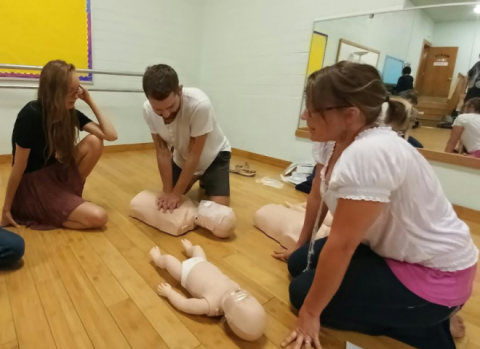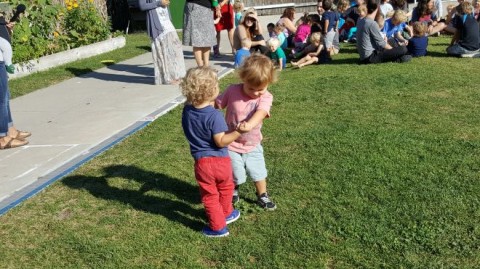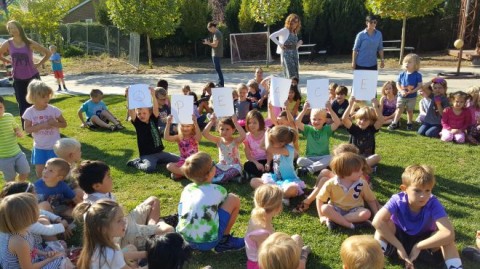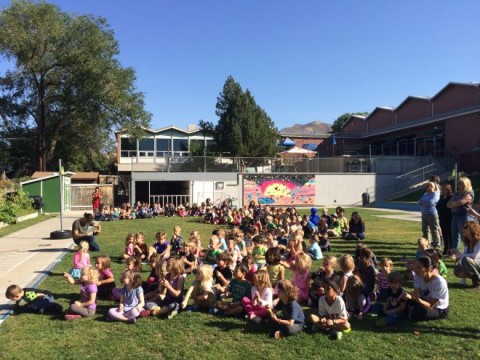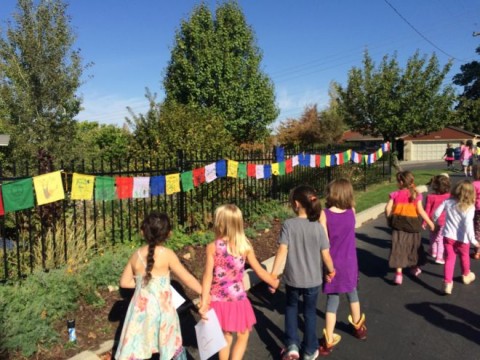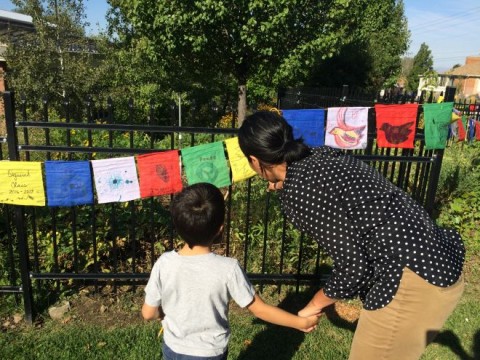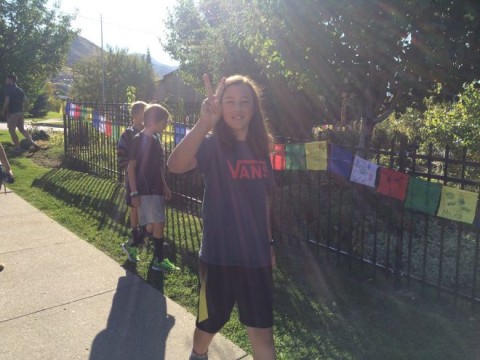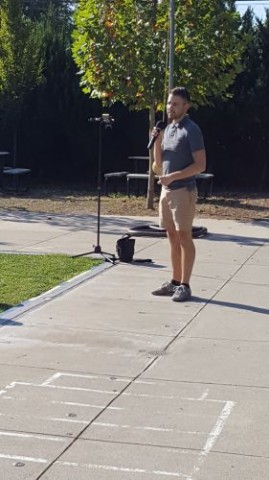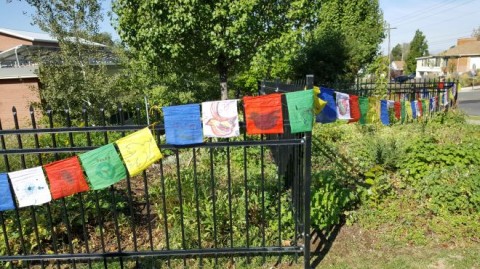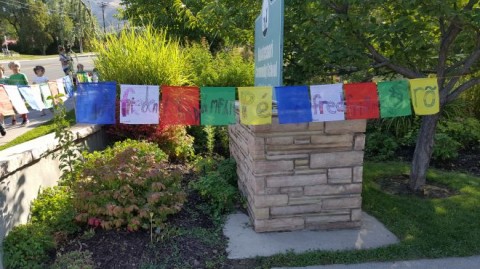“To consider the school as a place where instruction is given is one point of view.
But to consider the school as preparation for life is another.
In the latter case the school must satisfy all the needs of life.”
– Maria Montessori
The mission of the Montessori Community School is to provide a rich, educational experience that guides and nurtures the natural unfolding of the whole individual and inspires a lifetime passion for learning and peace.
The Montessori Community School has been established to encourage and promote the intellectual, physical and social development of children. The Montessori philosophy emphasizes the development of the child in a carefully prepared environment. A prepared environment is one in which the child is able to develop freely at his or her own pace, unhindered in the spontaneous unfolding of his or her natural capacities. This occurs through the manipulation of a graded series of self-correcting materials designed to stimulate the senses, and eventually one’s thinking, leading from perception to intellectual skills. Responsible freedom and inner self-discipline are encouraged. The joy of learning is emphasized and the child is helped to develop a positive self-image. We nurture self-worth. We affirm that self-worth is the crucial ingredient for the full expression of a person’s potential. We strive to base every interaction between community members on this principle — from how we discipline, to respecting personal learning styles and stages of development. This is the very fabric of our community and our educational methods. The social development of the children in the class is greatly emphasized. It takes place naturally as the children learn to respect each other and become affectionate and cooperative.
The Montessori Community School offers a traditional, comprehensive Montessori curriculum including Practical Life, Sensorial, Language, Math, Geography, History, Science, Spanish, Creative Movement/Dance, Music, Art, Computer Technology,Winter Sports, and Environmental Expeditions. Learning extends beyond the classroom through field trips, visitors, and community service.
Our Elementary program is split into two levels. Lower Elementary includes six to nine year old children (grades 1st – 3rd) and Upper Elementary includes nine to twelve year old children (grades 4th – 6th). At the Elementary level emphasis is placed on the students’ natural focus on social development and provides a safe environment to explore their developing moral compass. A majority of the time, lessons are given in small groups. The Elementary curriculum is rich and inviting. Along with moving at their individual academic pace, students practice important life skills including, but not limited to: time management, self regulation and direction, peaceful conflict resolution and contributing to the greater community.
The teachers create and adapt the environment with this community of children in mind. They modify the selection of educational materials available, the physical layout, and the tone of the class, to best fit the needs of the children. Our Montessori teachers serve as observers and guides in the classroom. Many of our teachers have been with us for over a decade and have more than ten years of experience with the Montessori Method.
“Education is a natural process carried out by the child and is not acquired by listening to words but by experiences in the environment.”– Maria Montessori
The Elementary Student
The elementary Montessori program and curriculum is structured around the very specific needs and characteristics of students between the ages of six and twelve years.
- Reason & Imagination – The inquisitive nature of the elementary student provides the fuel for the research and exploration focus of elementary Montessori. The elementary student wants to know the “why?” and “how?” The six- to twelve-year-old is able to use both reason and imagination to explore and understand increasingly abstract concepts.
- Exploring Society – While the early childhood student was primarily focused on the construction of the individual, the elementary student begins to explore his place in society. Opportunities continuously present themselves for the student to observe or participate, moments in which to lead or follow.
- A Need for Togetherness – This is the age of clubs and groups. The elementary student explores friendship and cooperation; they learn how to be a leader, a partner, and a follower. While collaboration is encouraged, individual contribution and strength is also valued.
- Exploring Right and Wrong – The six- to twelve-year-old student is actively developing his moral conscience; “That’s not fair!” is heard over and over again in the elementary classroom. Every student may know the rules, but keeping them is another matter. Problem solving techniques are modeled and fostered in the Montessori program. Community brainstorming for solutions and rules helps form the elementary Montessori classroom’s code of conduct.
- Freedom & Discipline – Independence and inner discipline continue to develop in the elementary years. The six- to twelve-year-old student is capable of increasingly complex and numerous responsibilities, and needs opportunities to exercise judgment and demonstrate self-conduct. Everything from classroom management to the student’s work stems from the student’s freedom to choose and think. Mistakes and failures are viewed as learning opportunities.
The Elementary Classroom
Students learn best within an environment prepared to nurture and enhance each student’s unique development.
- Multi-Age Groupings – Elementary Montessori classrooms are comprised of multi-age groupings. This is the practice of teaching students of different ages and abilities together, without organizing either the curriculum or the classroom by age or grade designations. The students remain in the same classroom, with the same instructors, for several years.
- Classroom Areas – The elementary Montessori classroom is divided into distinct curriculum areas: Science, Geography, History, Art, Math, and Language. Many of these subjects are then organized into separate skill areas. There is a large floor area for spreading out work, and gathering for community meetings and lessons. There are also tables for individual and group activities. The students have notebooks for recording their work and folders to store ongoing projects. Group supplies are located in a central area. A message board displays the day’s schedule as well as reminders and announcements. A wide variety of plants and animals are located throughout the classroom. Arrangements of cut flowers often decorate the tables and music is almost always playing in the background. Replicas of artists’ work adorn the walls. Cleaning materials are accessible to the students since they are custodians of their classroom. A library is located nearby and available for the students to visit in order to support their research and interests.
- Materials – The wealth of materials in each area allows the students to follow their own interests. Materials are arranged as to allow sequential progress in skills. Usually there is only one example of each material to encourage turn taking and patience. Materials and their activities vary from individual work, to partner work, to group activities. The materials are aesthetically pleasing with a great many being teacher-made. Many of the materials employ an internal control of error so as to encourage self-monitoring and foster independence in the elementary student.
The Elementary Montessori Teaching Method
Elementary Montessori programs emphasize active learning rather than passive reception of information.
- The Elementary Montessori curriculum builds upon the students’ early childhood experience. The Montessori materials continue to play an important role as the student transitions from the concrete to the abstract.
- Lessons involve exploration and hands-on experiences. The student in the Elementary classroom learns by doing hence the classroom is rich in materials, resources, movement and conversation.
- The curriculum is individualized. The needs, ability, interests, and skills of each student are taken into consideration when lessons are planned and knowledge assessed. The Montessori student will receive extra help or direction on areas where she needs it and move rapidly through other areas where she excels.
- The Elementary Program teaches the student how to think clearly, how to research, and how to express themselves in writing and speech.
- The program fosters independent work as well as group effort.
- The multi-age classroom creates an atmosphere of non-competition, making it possible for the student to work at her own pace, unrestricted by traditional grade standards.
- The program supports a variety of learning styles.
- Elementary Montessori education integrates all the different areas of study rather than compartmentalizing them.
The Montessori Teacher
“Follow the child” – as Dr. Montessori asserted, the Montessori teacher focuses on the whole child, and not on the daily lesson plan. Dr. Montessori wanted to create a clear distinction between the role of the Montessori teacher and that of a traditional teacher. She coined the new title “director” or “directress” for the adults in her classrooms and as the name implies, their role is that of a director of activities. Nowadays the term “guide” is more commonly used. The Montessori classroom is a student-centered environment rather than teacher-centered. The teacher is rarely the center of attention. They spends the majority of their time in individual or small group activity or observing the progress of the students.
The Montessori Guide:
- Tailors lessons and activities to suit the student’s learning style and abilities.
- Prepares the classroom environment to promote autonomy amongst the students.
- Maintains an investigation and discovery approach when presenting topics rather than giving facts and figures.
- Is trained to assess knowledge and achievement through observation of the student.
The Elementary Curriculum Overview
Different from a traditional school setting where teacher-directed curricula determines the daily lessons, the Elementary Montessori students choose their own work. Under the guidance of the teachers, the Montessori students select activities that reflect their ability levels yet present opportunities to practice and perfect skills. Students and teachers work together for large blocks of uninterrupted time within a classroom that is rich in resources. The students work at their own pace while the Montessori teachers observe and facilitate the learning process. The curriculum’s goal is to encourage students to become active learners rather than passive participants in education.
The Elementary Montessori Curriculum is designed to meet the needs of students between the ages of six and twelve. Elementary students have an increasing ability to abstract and to imagine; the curriculum engages the students in activities that utilize these affinities. While the curriculum builds upon the students’ early childhood classroom practice, it expands to include experiences, opportunities and instruction that are appropriate for the students’ developing minds. The Montessori materials continue to play an important role as the students transition from the concrete to the abstract. The teachers’ lessons involve exploration, research and hands-on experiences that guide the students in developing their reasoning minds.
Elementary studies include Geography, Biology, History, Language, Mathematics, Science, Music, Movement, and Art. Studies are enriched through field trips, visitors, and workshops that support the curriculum and expand the learning outside of the classroom into the community.
Mathematics
The Elementary Montessori Math Curriculum takes the students through a series of precise exercises using specifically designed materials that support the students’ emergent abilities to abstract. Using hands-on manipulative materials the students in 1st – 3rd grade are given tools by which to do their math work and so acquire a concrete understanding of math skills and knowledge. This solid foundation allows a smooth transition to abstract understanding and application of math skills during the 4th – 6th grades.
|
Lower Elementary |
Upper Elementary |
| Numbers |
Linear counting, sequencing, place value through millions, before & after numbers, , skip counting, ordinal & Roman numbers, one-step word problems, patterns & relationships |
Factors & multiples, rounding numbers to nearest 10s & 100s, prime numbers, squaring and cubing, estimating, multiple-step word problems |
| Operations |
+ – x / of whole numbers, regrouping, missing values, inverse operations, memorization of numerical patterns |
Large operations in all 4 operations (including long division, multi digit multipliers), operations involving decimals, memorization of tables, percentages, averages |
| Fractions |
Identification of fractions, addition & subtraction with common denominators, multiplication & division of fractions by whole numbers, equivalencies |
Mixed numbers, + and – of fractions with unlike denominators, simplifying fractions |
| Measurement |
Standard and metric units of measurement for length, mass & volume |
Perimeter, area, capacity, word problems |
| Time |
Telling time to the minute |
Elapsed time, 24 hour clock, word problems involving time |
| Statistics |
Interpreting data, block and bar graphs |
Line graphs |
| Geometry |
Classification of solids, quadrilaterals, triangles and polygons, study of lines & triangles |
Study of circles, congruency & symmetry, use of protractor and compass |
| Money |
Coin value, totaling amounts |
Making change, word problems involving money |
Language
The Elementary reading curriculum is designed to incorporate phonics, whole word, and phonetic exceptions. Lower Elementary students progress through a leveled reading program using the Pink, Blue, and Green Montessori reading exercises while additional materials and experiences allow them to perfect their reading skills, develop their fluency and comprehension. The Grammar and Vocabulary materials allow the students to assimilate an understanding of the structural rules that govern the English language. Literary elements are explored during Group Literature. Lower and Upper Elementary students practice writing on a daily basis in classroom journals that cover a variety of writing forms. In Lower Elementary, Writer’s Workshops are held throughout the year to target specific writing skills. In Upper Elementary the different varieties of writing and writing skills are integrated into their cultural, science and literature studies. Our goal is to help the students become comfortable using writing as a communication skill. Students learn to think clearly to research, and to express themselves with confidence and clarity in writing and speech.
|
Lower Elementary |
Upper Elementary |
| Reading |
Reading readiness, phonic skills, guided reading, sight words, contextual clues, S.S.R. (Silent Sustained Reading), vocabulary |
Shared reading, dictionary skills, fluency, expression |
| Comprehension |
Responding to questions regarding Story-time book (sequencing events, recapping & summarizing, identification of character, plot & setting) context clues & main ideas |
Continued study of main ideas, sequencing & context clues, assumptions/inferences, following written directions & instructions |
| Penmanship |
Metal inset exercises, D’Nelian print & cursive, spacing, left justification, neatness |
Mastery of cursive |
| Spelling |
Unconventional to conventional, leveled spelling works |
Conventional spelling lists, spelling demons, vocabulary, spelling rules |
| Mechanics |
Ending punctuation, capitalization, commas |
Apostrophes, commas, quotation marks |
| Composition |
Complete sentences, journaling, picture prompted stories, modeled writing, editing |
Journaling, character & plot development, proofreading, revising, publishing |
| Study Skills |
Categorizing, table of contents, index, beginning reports |
Outlining, note taking, organizing information, skimming, advanced reports, paraphrasing |
| Grammar |
Parts of speech, parsing |
Sentence analysis, verb tenses |
| Speaking |
Poetry presentations, in-class reports, drama, story-telling |
Poetry presentations, in-class reports, drama, story-telling |
Research Skills
In the Elementary classroom, research skills and the preparation of reports are major components of the educational program. In Lower Elementary, students begin learning the skills needed to research areas of interest or assigned topics, and how to communicate their learning through reports—both formal and informal, written and oral. These skills continue to be examined and employed in Upper Elementary.
A special series of lessons, called the “Great Lessons,” are presented each year. These beautifully told stories give an overview of the formation of the universe, and provide the student with an understanding of the human’s place in time and space. The Great Lessons provide the foundation for study in Geography (How the world came to be and the development of life on Earth), Math (The development of mathematics), Language (The development of language and writing), and History (The story of humans). The students are given the broad story and proceed to fill in the details during the course of their Elementary years through subsequent “key” lessons. The intent of the Great Lessons is to create in the students a sense of admiration and wonder. They will then be compelled to discover more on their own.
Cultural Studies
The Elementary Montessori curriculum uses the term “Cultural Studies” for History, Geography, and the Sciences.
|
Lower Elementary |
Upper Elementary |
| Physical Sciences |
Process of scientific inquiry, Experiments, Three states of Matter, Studies of the Earth, Solar System |
Process of scientific inquiry, Experiments, Physics, Chemistry |
| Life
Sciences |
The Five Kingdoms, External parts of Animals, External parts of plants, Body Systems |
The Five Kingdoms, Classification, Internal functions of animals, Internal functions of plants, Body Systems & Functions |
| History |
Days of the week, months, timelines; Study of civilizations, Vertical studies of the fundamental needs of man – clothes, shelter, transportation, defense, communication; US & State History |
Earth History Timeline, Study of ancient civilizations, US & State history, World History |
| Geography |
Identification of continents, oceans and countries; Map reading and making; Biome studies; Land & water formations; Studies of countries |
Longitude & Latitude coordinates, Scale, Biome Studies, Identification of world land & water formations, Study of countries, states & regions |
Science
The Elementary Montessori curriculum includes the Physical and Life sciences. Studies in this discipline follow a three-year rotation.
| Lower Elementary
|
|
Year One |
Year Two |
Year Three |
| Life Sciences |
Fossils, Life cycles, Flowers & Herbs, Germination, Digestive System |
Classification, Vertebrates, Trees, Circulatory System |
Food Chains, Invertebrates, Fruits & Vegetables, Recycling, Skeletal System |
| Physical Sciences |
Rocks & Minerals, Sun & Stars, Simple Machines, Magnetism |
Faults & Earthquakes, Solar System, Light & Sound |
Continental Drift, Volcanoes, Moon, Electricity & Heat |
| Upper Elementary
|
|
Year One |
Year Two |
Year Three |
| Earth Science |
Atmosphere |
Hydrosphere |
Lithosphere |
| Body Systems |
Nervous System |
Respiratory System |
Reproductive System |
| Physical Science |
Chemistry |
Physics |
Astronomy |
| Biology |
Plant Kingdom |
Animal Kingdom |
Protista, Monera, Fungi |
Geography & History
Our Elementary students are exposed to a global cultural perspective, learning to understand and appreciate a multicultural world. The students participate in an annual Cultural Fair each spring, which is a culmination of that year’s continent or history focus. For example, if Africa is our continent focus for a particular year, each student would undertake in-depth research on a particular country and develop a multi-dimensional presentation for the Cultural Fair that is representative of their country (i.e. traditional foods, clothing, instruments, written reports, 3-D representation of topographic features, rivers and mountains, etc.). When our Upper Elementary students were studying the Vikings and Ancient Rome, they designed costumes, made traditional tools and food, developed video presentations, and wrote in-depth reports to showcase their studies. The Cultural curriculum is examined in three-year cycle.
| Lower Elementary
|
|
Year One |
Year Two |
Year Three |
| History |
Inca & Maya, Colonial America, Utah’s Statehood |
Ancient Egypt, Middle Ages, Frontier Studies |
Explorers, Native Americans |
| Geography |
North & South America, Mountains & Caves |
Europe & Africa, Lakes & Rivers |
Asia, Australia & Antarctica, Deserts |
| Utah Studies |
State Mineral, State Gem, State Flower, State Fossil, Surrounding States |
State Tree, State Fish, State Animal, State Bird, Great Salt Lake |
State Fruit, State Vegetable, State Insect, State Symbol, State Motto |
| Upper Elementary
|
|
|
Year One |
Year Two |
Year Three |
|
| World History |
The Aztecs |
The Vikings |
Ancient Rome |
|
| American History |
Colonial America
Transcontinental Railroad |
Westward Movement – Mountain Men, Pioneers
Utah Statehood |
Native Americans |
|
| Geography |
Physical Studies – North & South America, Country Study – USA |
Cultural Studies – Europe & Africa, Country Study – Ireland |
Economic Studies – Asia & Australasia, Country Study – New Zealand |
|
| Utah |
Physical Studies |
Political Studies |
Economic Studies |
|
|
|
|
|
|
|
|
Practical Life
The main focus of Practical Life at the elementary level is guiding the student toward responsible independence in action and thought. Students learn to manage their work and time using a log to plan their day. Once the students are familiar with using a logbook, they learn to evaluate their own work and then practice goal setting. At the Lower Elementary level students plan a day at a time while at the Upper Elementary level they create a week’s plan.
Elementary students care for classroom animals, provide basic maintenance of their classroom, and learn skills such as flower arranging and knitting. Business ventures include creating products for the monthly market and managing a staff food service business. Practical Life in both Lower and Upper Elementary include school and community services and chores. These include managing our school-wide recycling and composting programs, and creating annual campaigns to help our community have more of an awareness on issues such as waste management.
Students are encouraged to fully participate in their learning process by doing research and discovering information for themselves.
The Elementary approach to classroom management is to help the students learn that they are responsible for what they do and that their actions have natural consequences. Students are involved as much as possible in the development of the Elementary Code of Conduct. Whether a problem involves only two students or the whole class, we teach the students a “Work it Out” method to help them to become problem solvers. Problem solving techniques are modeled and fostered. One of the techniques that the teachers use is called “Teacher Theater,” where they model appropriate conflict resolution. The classroom also has an Agenda Book that provides the students with the opportunity to raise issues that are significant to the Elementary community.
Community brainstorming for solutions and rules helps form the Elementary Classroom Code of Conduct. The students are given increasingly complex and numerous responsibilities, and many opportunities to exercise judgment and demonstrate self-conduct. Mistakes are viewed as learning opportunities.
Each year, the Upper Elementary students are given the opportunity to define the values that they will adopt and practice as a class. Recent examples include the values of responsibility, respect and tolerance. Upper Elementary students also participate in Socratic Dialogue, which involves open-ended discussion on topics that influence the world around them, as well as the exploration of new ideas.
Great Outdoors Environmental Program (“GO”)
Throughout the year, Upper Elementary students and third year Lower Elementary students participate in an environmental education program called, “The Great Outdoors.” This program combines classroom and field studies in local environmental issues and ecosystems. Environmental expeditions involve observations and studies of local biomes and Salt Lake City’s water systems as well as conservation and ecological service projects such as the Bear River Cleanup.
Art
Art Supplies are available in the classroom for students to select as part of their daily work. Students also have an Art Specialty class, where they refine basic art techniques such as pattern, design, texture, shape and line, and learn more advanced techniques such as perspective, medium, shading, dimension, transparency, overlapping, and printmaking. During the Spring Art Showcase, our students have the opportunity to share their artwork with our school community.
Each month, the students study the life and work of a famous artist. We rotate these artists over the following three-year cycle:
| Lower Elementary
|
| Year One |
Year Two |
Year Three |
| Gustav Klimt |
Vincent Van Gogh |
Leonardo da Vinci |
| Piet Mondrian |
Georges Seurat |
William Morris |
| Norman Rockwell |
Paul Klee |
Edvard Munch |
| Andrew Wyeth |
Grandma Moses |
Frida Kahlo |
| Mary Cassatt |
Henri Matisse |
Frank Lloyd Wright |
| John James Audubon |
Roy Lichtenstein |
Katsushika Hokusai |
| Jackson Pollock |
Ansel Adams |
Pablo Picasso |
| Gilbert Stuart |
MC Escher |
Dorothea Lange |
| Andy Warhol |
Georgia O’Keeffe |
Claude Monet |
| Upper Elementary
|
| Year One |
Year Two |
Year Three |
| Giotto di Bondone |
Limbourg Brothers |
Michelangelo |
| Carl Linnaeus |
Fra Angelico |
Gustave Courbet |
| Lorenzo Ghiberti |
Albrecht Dürer |
Edgar Degas |
| El Greco |
Rembrandt van Rijn |
Berthe Morisot |
| Winslow Homer |
Edouard Manet |
Paul Gauguin |
| Auguste Rodin |
C.M. Russell |
Salvador Dali |
| N.C. Wyeth |
Henry Moore |
Louise Nevelson |
| Victor Vasarely |
Christo |
Wassily Kandinsky |
| Diego Rivera |
Méret Oppenheim |
Joseph Stella |
Music
Students have a Music Specialty Class, which provides formal instruction in music. Using ORFF instruments and recorders, the students learn to keep a steady beat, play rhythm rounds with non-pitched instruments, and read music on the staff. The students have the opportunity to share what they have learned in Music Specialty Class with our school community during the annual Spring Performance.
Each month, the students study the life and work of a famous composer. We rotate these composers over the following three-year cycle:
| Year One |
Year Two |
Year Three |
| Miles Davis |
Beethoven |
Aaron Copland |
| John Philip Sousa |
Elton John |
Johann Pachelbel |
| Ferde Grofé |
Wagner |
George & Ira Gershwin |
| Cole Porter |
Prokofiev |
Irving Berlin |
| Duke Ellington |
Vivaldi |
Meredith Monk |
| Rodgers & Hammerstein |
Gilbert & Sullivan |
Frederick Chopin |
| Scott Joplin |
Enya |
Marvin Hamlisch |
| John Williams |
Mozart |
Aretha Franklin |
| Bob Marley |
The Beatles |
The Beach Boys |
Dance
Students have a Dance Specialty Class, which provides formal dance instruction. In Dance Class, students work on dance elements such as high and low space, slow and fast energy, positive and negative space, tempo changes, different energy levels, high and low planes, and mirroring. The students refine their locomotion skills, which include sliding, galloping, skipping, jumping, crawling, and rolling. The students have the opportunity to share what they have learned in Dance Specialty Class with our school community during the annual Spring Performance.
Theater
The students study elements of theatre and have the opportunity to participate in our annual Montessori Community Theater performance, which is attended by Kindergarten and Elementary school students and parents. Poetry recitals occur throughout the year, and at the end of the school year, the students present small skits and songs based on their classroom studies.
Physical Education
Physical education is an important part of the Elementary Montessori Curriculum. Emphasis is placed on body awareness and physical fitness through playing cooperative games and practicing Yoga. Elementary students also spend a great deal of time hiking and exploring the great outdoors on field trips throughout the year. Students also have at least 30 minutes of outdoor playtime daily where they may choose to play on the playground, organize their own sports or creative activities, or just relax.
Winter Sports Program
Each year, Elementary students take part in a five-week Winter Sports Program. The students have the opportunity to take skiing or snowboarding lessons at Brighton Resort.
Field Trips
Field trips enhance the year’s curriculum. The students extend their learning beyond the classroom by making several off-campus trips each month to locations such as art exhibits, hiking trails, theatre productions, museums, cultural exhibitions, local farms, and nature preserves. The students also make frequent visits to Salt Lake City area libraries throughout the year to choose books for classroom reading time or for research projects.
Technology
Computers are introduced to the Elementary students when they are ready to publish their writing and research. Students learn how to word process, save, and edit their work. The use of the Internet is carefully supervised. Students learn how to access online dictionaries and encyclopedias. Keyboard skills are also introduced, typically during the third year of Lower Elementary. Upper Elementary students develop skills in Word processing, Power Point presentations, video and photography, and classroom blogging.
Home Assignments
Each month, Lower Elementary students are given a Home Assignment, which is typically a project involving library research and hands on learning. Students are not given “busy work”. Home Assignments are designed to extend and enrich the curriculum, challenging the students to think and explore. For example, as part of their Egyptian studies, our Lower Elementary students made Egyptian paper, traditional dolls and scarabs. As part of their medieval studies, the students designed castles out of a material of their choice, labeling all of the parts of the castle.
Testing
We do not use standardized testing as a means of evaluating student progress. Our method of evaluation includes detailed recordkeeping on each student and direct observation of the application of skills and concepts introduced to each student throughout the year. Elementary parents receive two written evaluations, and participate in two student-led Parent/Teacher Conferences each academic year. This method of evaluation enables the student to master a concept or skill before progressing and allows us to identify and address any learning issues that may be preventing that student from moving forward. It also allows students to move forward rapidly in areas where understanding comes easily and take more time to comprehend areas that may be more difficult for them.
Freedom and Responsibility
Montessori Elementary students are guided in taking on an important role in their own education. They often have the freedom to choose work partners and topics of study, learning to balance freedom with responsibility. This nurtures adaptability, negotiation, compromise, problem solving, time management, and respect for others and the environment. They develop leadership skills by making important decisions on projects related to their elementary community life, as well as giving presentations and voicing their opinions in community meetings throughout the year.
Community Life
Students learn to become active, positive contributors to their school community, and many events throughout the year such as Elementary/Middle School Community Meetings and the Fall and Spring Elementary/Middle School Camping Trips provide ample opportunity for the students to practice these skills and to develop a strong sense of community.
Outcomes
The outcomes of the Montessori Elementary Program are:
- Students learn how to learn
- Students become independent
- Students are active learners
- Students learn to manage their time
- Competency and skills in all areas of the curriculum
Montessori Elementary students find deep personal satisfaction in learning through their own efforts. They do not compete against each other for grades, or expect external rewards for their work. Students learn to trust themselves and their own judgments. More importantly, they can acknowledge mistakes and work to correct them in an atmosphere of support and respect. The students take ownership of their work and their environment, and develop self-direction. They develop an innate drive to learn and a natural love for learning that lasts a lifetime.
